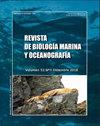2012-2019年在墨西哥湾墨西哥海岸发现和报道的巨型虎对虾(十足目:对虾科)
IF 0.5
4区 生物学
Q4 MARINE & FRESHWATER BIOLOGY
引用次数: 0
摘要
这项工作显示了2012年至2019年在墨西哥湾墨西哥海岸记录的斑节对虾的最新目击和报告,并报告了在西大西洋发现的最小标本。结果显示,自第一次报告以来,目击事件和报告增加了近300%。目击和报告最多的地区是坎佩切和尤卡坦海岸。捕获标本的大小和分布范围很广,包括在西大西洋发现的最小标本,以及性腺成熟晚期的雌性标本,这表明斑蝶已经在该地区站稳脚跟。这种设置可能产生的负面影响使得有必要根据科学证据提出措施。本文章由计算机程序翻译,如有差异,请以英文原文为准。
A review of recent sightings and reports of the giant tiger shrimp Penaeus monodon (Decapoda: Penaeidae) on the Mexican coast of the Gulf of Mexico (2012-2019)
This work shows an update of the sightings and reports of tiger shrimp Penaeus monodon on the Mexican coast of the Gulf of Mexico recorded from 2012 to 2019 and reports the smallest specimen found in the western Atlantic. The results show an increase of almost 300% in sightings and reports since the first report. The zone with most sightings and reports was the coast of Campeche and Yucatán. The wide range of size and distribution of the captured specimens, including the smallest specimen found in the western Atlantic and the presence of females at an advanced stage of gonadal maturity, indicates that P. monodon has established itself in the area. The possible negative effects of such establishment make necessary the proposal of measures based on scientific evidence.
求助全文
通过发布文献求助,成功后即可免费获取论文全文。
去求助
来源期刊
CiteScore
0.70
自引率
0.00%
发文量
41
审稿时长
12 months
期刊介绍:
Publicar desde una perspectiva científica, artículos originales, decididos por un proceso de revisión por pares, invitando a expertos de reconocido prestigio en el área. Los trabajos publicados se caracterizarán por su solidez teórica-metodológica, actualidad y relevancia para las ciencias marinas.
Se reciben trabajos inéditos derivados de la investigación científica realizada en ambientes marinos y estuarios, en formato de Revisión, Artículos, Notas Científicas, y Obituarios en las siguientes disciplinas::
Biología-Ecología marina
Oceanografía física, química y biológica
Contaminación marina
Geología marina
Sistemática, Faunística y Biogeografía Marina
Manejo Costero
Acuicultura marina
Pesquería marina.

 求助内容:
求助内容: 应助结果提醒方式:
应助结果提醒方式:


